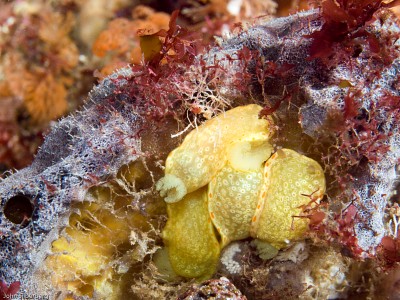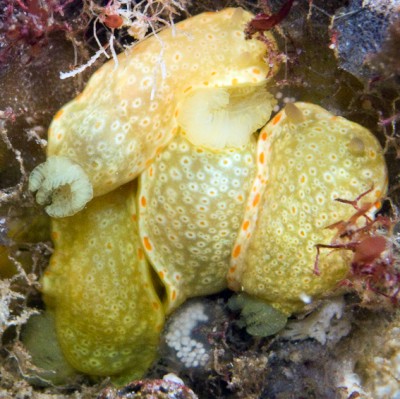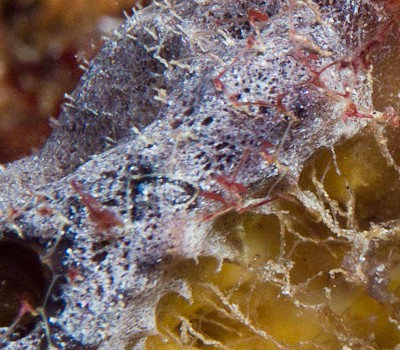Re: Chromodoris multimaculosa from Bicheno, Tasmania
May 31, 2010
From: Capt John Silberberg

Concerning message #23688:
Hi Bill
They were still there on 28 May 2010.
There was a heavy surge and while I was watching, one was washed out. I caught it, photographed it and returned it to the reef.
Locality: The Rock, Waubs Bay, Bicheno, 12 metres, Tasmania, Australia, Tasman Sea, 28 May 2010, Rocky Reef. Length: 15 mm. Photographer: Capt John Silberberg.
Also, better pics attached, including what appears to be an egg mass.
Cheers
John.
john.silberberg@bigpond.com



Dear John,
Thanks very much for these much clearer photos. As Greg Close says in his accompanying message [#23694] I was wrong in identifying your animal as C. multimaculosa, they are a spotted form of C. epicuria. In these photos the mantle is clearly translucent with white surface pigmentation.
The egg mass is interesting because the large eggs suggest the owner of them has direct development which means that the eggs hatch out as small crawling slugs rather then as small free-swimming veliger larvae. I can't find any record of its eggs so it would be interesting to know if anyoine else has found similar egg masses associated with C. epicuria.
The other interesting bit of information I can get from your photos is that they are clearly eating a large sponge colony and from the stringy network of fibres we can see it most probably a darwinellid sponge. Certainly the purplish outer layer of the colony is almost certainly Chelonaplysilla violacea but I am not sure whether the inner yellow region is a separate sponge or the inner pasrt of the Chelonaplysilla colony. Whatever it is, the nudibranchs have burrowed deeply into it. Large clusters of feeding animals like this support the idea that this is a direct developing species. For example, the southeastern Australian species, C. tasmaniensis, is a direct developer and is often found in groups like this on its favoured sponge Darwinella gardineri. I have reported C. epicuria feeding on D. gardineri, so your photos showing it in Chelonaplysilla violacea is a valuable addition to our knowledge.
Best wishes,
Bill Rudman
Related messages
-
Re: Chromodoris multimaculosa from Bicheno, Tasmania
From: Greg Close, May 31, 2010 -
Chromodoris multimaculosa from Bicheno, Tasmania
From: Capt John Silberberg, May 29, 2010 -
Can you please id this nudi?
From: Trevor McMurrich, October 26, 2006 -
Chromodorid from S.E. Australia
From: John Chuk, June 26, 2002 -
Chromodoris epicuria from South Australia
From: Stuart Hutchison, March 8, 2002 -
Chromodorid from South Australia
From: John Chuk, August 21, 2001
